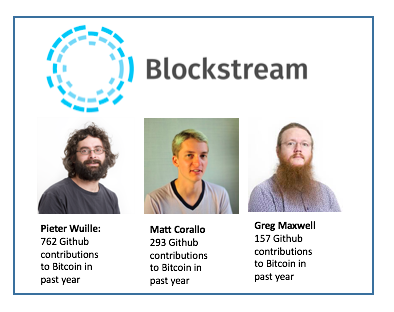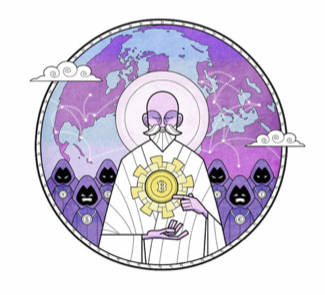Understanding Blockstream
San Francisco-based Blockstream is arguably the most important and misunderstood company in the Bitcoin world.
As an engineer-driven organization, Blockstream has not communicated much externally up to this point. I recently sat down with co-founder and CEO Adam Back to better understand the company, its mission and vision, and the distinction between Blockstream and Bitcoin Core, the group that leads Bitcoin protocol development. There has been some disagreement in the ecosystem over the past few years; stronger alignment across users, exchanges, wallets and miners will go a long way in bringing Bitcoin to more people in the world.
Here’s what I learned:
The Importance of Blockstream
Bitcoin is an open-source software project where anyone can view the code and submit changes, but only a small group of maintainers can approve the changes and push the changes live into production. Blockstream employs many of the most experienced and productive Bitcoin Core developers, including Greg Maxwell, Pieter Wuille and Matt Corallo, who have made over 1,212 GitHub contributions to Bitcoin over the past year (see here for an overview of the highlights). For that reason, individuals at Blockstream arguably hold the most crypto protocol knowledge and influence in the world.

Blockstream employs many of the best minds in the crypto world
Blockstream is led by Adam Back, the inventor of Hashcash and one of the best crypto-economic minds in the world. The company has raised over $76M from Khosla Ventures, Horizons and others, and LinkedIn founder Reid Hoffman is on its board. Individuals at the company have conceived many of the most important blockchain innovations that the world has seen, like sidechains and segregated witness, among many others.
In addition to all of their Bitcoin work, individuals at Blockstream have been long-time contributors to a number of non-Bitcoin open-source groups including the IETF, W3C, the Linux Foundation and Hyperledger. The company has open-source software and user rights in its DNA and follows large established companies like Red Hat and Mozilla in its commitment to transparent, inclusive software development.
The Confusion about Blockstream
While the positive impact that many individuals at the company have had on Bitcoin is clear, some blame the company itself for the lack of experimentation and progress of Bitcoin at the protocol level in the past few years.
Bitcoin Core has a general reputation for being risk averse when making changes to Bitcoin. Most notably, Core has not supported increasing the block size as quickly as some would like to increase the network’s ability to process transactions (currently, Bitcoin can handle around 7 txns/sec, which is small compared to the approximately 2,000 txns/sec processed by Visa on average). Some in the community fear this will soon become a bottleneck for user adoption and have even made proposals for new clients and developer teams (for example, see Bitcoin Unlimited, which investor Roger Ver has recently supported).
Much of this sentiment stems from a misunderstanding about the governance structure of Bitcoin. Bitcoin has been described as democratic, but the reality is that Bitcoin is not a representative democracy where officials are elected and given autonomy to make decisions. Bitcoin is instead a user-controlled system where the code is bound by all of the participants in the network (developers, miners, users, exchanges). No one group has the ability to make major protocol changes and a super majority vote is actually required to do so. This can be viewed as both a gift and a curse: it makes Bitcoin the most anti-fragile store of value that has ever existed, but it also makes it challenging for changes to be made to the protocol.
Despite this fundamental design of Bitcoin, Blockstream has been a popular scapegoat for those frustrated by the lack of faster progress. Blockstream as a company has little to do with Bitcoin Core though: it has 20 engineers on staff and only 1 full-time Core contributor (Peter Wuille). Several other members of the Blockstream team contribute to Core part-time, but there were 517 Github contributors in total in 2016. Blockstream is very much focused on building on top of Bitcoin rather than changing the Bitcoin protocol itself.
So What’s the Role of Blockstream in the Ecosystem?
When the company raised its seed funding, the narrative was that Blockstream would become for Bitcoin what Mozilla is for the Internet: a for-profit entity committed to upholding the core values of the protocol.
It has now been over two years since Blockstream announced its launch and it appears to some that the company has gotten away from that. A popular perception is that Blockstream uses its influence over Bitcoin Core to make decisions based on what’s best for the company, not the Bitcoin ecosystem as a whole.
Below is my discussion with Dr. Back, who took time to discuss the past, present and future of Blockstream:
NT: What is the mission of Blockstream?
AB: We believe in a future where users are empowered to control their own assets. Our mission is to take the core secure P2P functionality of Bitcoin and extend it to other digital assets so that decentralized, P2P finance can come to fruition.
NT: Why do you think building on Bitcoin is the best way to bring decentralized, P2P finance to the world rather than using newer, more flexible blockchains like Ethereum?
AB: Bitcoin is the most secure and robust decentralized value transfer network. It has been running for eight years with no downtime, has more processing power dedicated to it than the largest supercomputer in the world and has a simple scripting language with the smallest attack vector. Other blockchains like Ethereum are interesting experiments, but they do not match Bitcoin in terms of reliability, security and decentralization. Financial institutions that value reliability, security and decentralization for digital assets are likely going to want solutions on top of Bitcoin, like what we’re building at Blockstream.
NT: At launch, Blockstream was described as “Mozilla” but for Bitcoin. Is that still a model you are striving for?
AB: Yes. Our lead seed investor Reid Hoffman initially described Blockstream being similar to Mozilla in upholding the core values of the protocol and we still very much strive for this vision. We employ many people who contribute to the Bitcoin protocol and improve on the secure, decentralized system that Satoshi built. As a company, we are building on top of Bitcoin in a way that sticks true to the values of decentralization, inclusion, security and openness.
In terms of what we’re actually building, we’re primarily focused on taking the sidechains innovation and applying it to financial institutions so that they can empower users around the world to access and move digital assets in a more efficient manner.
NT: Many of the venture-backed companies in the space who want fast growth have expressed frustration with the progress of Bitcoin Core. Some have even suggested Blockstream is “anti-big blocks” for its own self-interest. What is the primary reason that Bitcoin hasn’t shipped faster and implemented features that the community wants, like bigger blocks?
AB: Blockstream and Bitcoin Core are different entities. Bitcoin Core is an independent group of developers that makes decisions based on what’s best for the ecosystem as a whole and takes into account the interests of all parties (users, miners, exchanges, wallets, etc). This is incredibly challenging; different parties have different interests and there are billions of dollars of value in the network — so messing something up is not trivial. As a result, Bitcoin development looks more like aviation safety development than consumer app development. Robust testing and peer review is essential.
Most of those who have expressed frustration are not close to the situation. It’s easy for an outsider to look at a product and say that nothing is happening at the engineering level. An outsider who looks at a service like Uber may wonder what the 1,200+ Uber engineers did in 2016 — they didn’t ship many new features! The reality is that when you have a complex platform with millions of users, there’s a lot of upkeep and optimizing that needs to be done. There was actually a lot of developer activity in
Bitcoin in 2016 and I think the Core devs did a good job focusing on upkeep and optimization.
Regarding scaling Bitcoin, I believe Core has always been on the side of scaling—the challenge has been figuring out the best way to get there. I’m optimistic that Segwit is the scaling answer that we’ve all been looking for and hopeful that the miners will activate it soon.
Note: See support for Segwit here. 30% of blocks currently have Segwit activated — a 95% threshold needs to be met to go into effect.
NT: What is the status of sidechains? Some have described it as a dead project — how do you view the progress?
AB: With sidechains, we’re ultimately striving for decentralized, secure, reliable P2P digital assets that anyone can use in an interoperable manner across blockchains. This is a big long-term vision that will take a lot of R&D — it can’t happen immediately.
In October 2014, we released the sidechains whitepaper. In June of 2015, we launched Elements, the first working implementation of sidechains. This inspired a number of other exciting sidechains projects, like Rootstock and Hivemind. In October 2015, we launched the Liquid protocol, which is our first production sidechain. This protocol makes bitcoin exchanges interoperable. Bitcoin exchanges are just the first test case for the technology and it can be applied across a number of financial assets.
While we’ve made a lot of progress, sidechains are currently federated rather than truly decentralized. There’s a lot of work to be done on this front still.
NT: What are the Blockstream initiatives that you are most excited about for 2017?
AB: We’re excited to enable more financial institutions to use our infrastructure stack in 2017. We currently have partnerships with systems integrators like PWC and expect to see more in 2017. We’re also excited to deeply integrate Greenaddress wallets, a recent acquisition of ours, into the stack so that partners can securely and conveniently use digital assets.
Lastly, we’re excited to continue to support Bitcoin development and grow the ecosystem by fostering a healthy open-source ecosystem and attracting great developers.
NT: Thanks Adam. Appreciate the time.
Resources
The best thing about Bitcoin development is that anyone in the world can participate. If you want to learn more about Blockstream and Bitcoin Core, I encourage you to do the following:
- Learn more about Sidechains, Segwit, Lightning and more
- Join the Bitcoin Core Slack
- Follow CEO Adam Back on Twitter
NOTE: THIS WAS ORIGINALLY PUBLISHED ON MEDIUM
About me: I run The Control and am an investor at Runa Capital, an early stage venture fund. Previously, I worked on business development and marketing at Coinbase and as an Associate at North Atlantic Capital. My work has been featured in publications like the Wall Street Journal and Entrepreneur and I’ve guest lectured at the Yale School of Management. Follow me on Twitter and signup for our newsletter!


Hi! I am a robot. I just upvoted you! I found similar content that readers might be interested in:
https://thecontrol.co/understanding-blockstream-25af2b6f0084
I am fascinated by bitcoin and it's evolution. That said, my husband said no i could not invest into bitcoin or a currency that threatens the American dollar. I married into a military family so I respect that to them country comes first. I get to use steem it because it is an avenue for me to make friends, share my art works, and access information about the world in a safe place. The monetary value of steem it is something I don't like to discuss but seems very important to most users. To me it's the thing that will get me banned from the site. I am excited for other people though because I feel like steem it is something better than just a currency. I consider it a community if you will of creative innovative people looking for an outlet to express themselves. Where does steem it fit into among the crypto currency world?
Thanks very much. I wonder if blockstream is in support of the theory of "hands off" capitalism and letting people vote with dollars or bitcoin on what should be successful in the economy. If the government should keep their hands of people's money then supporting that is not anarchism it's capitalism. So if bitcoin is to be the new capitalism then how will they give the users a role. This is why services like Steemit should be valuable to bitcoin.